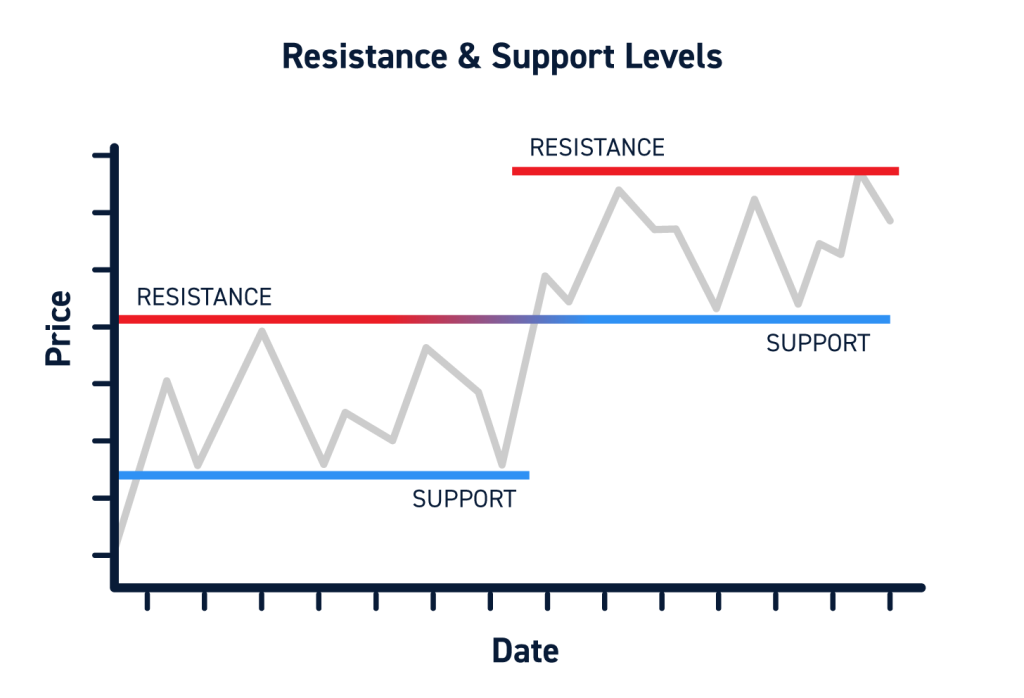Learn Trading for Free and Without Registration
An Online Glossary to Study Trading Independently
Support and Resistance
Support and Resistance Levels: What They Are and Why They Work
If you examine charts on any timeframe, you’ll notice a recurring pattern: price reversals almost always happen near the same levels where they occurred before. This isn’t a coincidence but a fundamental market phenomenon driven by the balance of buyers and sellers. Support and resistance levels are essential tools in technical analysis, helping traders identify where price might pause, reverse, or continue its movement.
But why do these levels exist? The answer lies in the mechanics of the market, specifically in the order book, where buy and sell orders cluster around certain price levels. Let’s explore how these levels form, why they work, who benefits from them, and their importance for traders.
What Are Support and Resistance Levels?
- Support is a price level where demand (buying interest) exceeds supply (selling interest), preventing the price from falling further. Think of it as a "floor" from which the price bounces upward.
- Resistance is a price level where supply exceeds demand, preventing the price from rising further. It acts as a "ceiling" that the price struggles to break through.
These levels are formed when significant numbers of market participants decide to open or close positions at certain prices. Common factors influencing support and resistance include:
- Psychological levels: Round numbers like 1.2000 or 100.00 often attract attention.
- Previous extremes: Historical highs and lows where price reversed.
- Technical indicators: Tools like trendlines, Fibonacci levels, and moving averages often align with these levels.

Why Do Support and Resistance Levels Work?
To understand how these levels function, we need to examine the mechanics of the order book.
The Order Book Mechanism
Every trade on the market happens because a buyer and a seller agree on a price. At any given moment:
- If buyers are willing to purchase 500 lots at 1.2000, but sellers are only offering 300 lots, the remaining demand will push the price higher.
- Conversely, if sellers want to sell 500 lots while buyers are only willing to purchase 300, the price will drop.
These areas, where orders remain partially unfilled, become support or resistance levels. Traders return to these levels in the future because:
- Unfilled orders remain active: Many participants set pending orders at these levels.
- Psychological significance: Traders remember where the price paused or reversed before and expect similar behavior.
Who Benefits from Support and Resistance Levels?
-
Institutional Players:
- Large funds and banks executing high-volume trades cannot fulfill their orders all at once. They break them into smaller chunks, often around key levels, to minimize market impact.
- For example, a bank aiming to buy 10,000 lots may start buying at 1.2000, gradually filling its order book.
-
Retail Traders:
- Support and resistance levels guide retail traders in making decisions, such as buying at support or selling at resistance.
-
Speculators:
- Short-term traders, including scalpers, use these levels to identify quick trading opportunities.
How Are Support and Resistance Levels Formed?
1. Reversals at Familiar Levels
History often repeats itself. If a price previously reversed at a specific level, it is likely to do so again due to the accumulation of orders in that zone.
2. The End of Long-Term Trends
When a price experiences a substantial move (e.g., 1,000–2,000 points), large players may begin taking profits, slowing or halting the trend and forming a level.
3. Technical Levels
Fibonacci retracements, moving averages, and other indicators often coincide with key support and resistance zones, adding to their reliability.
Key Features of Support and Resistance Levels
-
Role Reversal:
- A broken resistance level often becomes a new support level as traders who missed the breakout look to buy on a pullback.
- Similarly, a broken support level can act as resistance in a downtrend.
-
Zones, Not Lines:
- Support and resistance are not exact prices but rather zones. The price might overshoot or fall short of these levels.
Recommended Tolerances by Timeframe:
- M5–M15: 3–5 pips.
- M30–H1: 5–10 pips.
- H4–D1: 20–40 pips.
- W1: 50–100 pips.
The higher the timeframe and the more volatile the asset, the wider the zone should be.
Support and Resistance in Patterns and Strategies
Support and resistance levels are integral to many chart patterns, such as:
- Flags and Rectangles: The horizontal lines of these patterns act as support and resistance within a range.
- Head and Shoulders: The neckline often serves as a significant support or resistance level.
These levels also form the foundation for many strategies, like Sniper X, where entry points are determined by the price’s reaction to support and resistance zones.
Conclusion
Support and resistance levels are critical components of market analysis, providing traders with insights into potential price behavior. They exist due to the actions of market participants, the mechanics of the order book, and psychological factors.
Understanding and effectively using support and resistance can significantly enhance your trading performance. To learn more about mastering these concepts and applying them in real-world trading, join our academy. Our strategies, rooted in the principles of support and resistance, will help you make confident, informed decisions in the market.


